The Broken Chloroplast Gene Clusters in Gymnosperms Exhibit Elevated Substitution Rates
Abstract
:1. Introduction
2. Materials and Methods
2.1. Sequence Data
2.2. Construction of Phylogenetic Relationships
2.3. Calculation of Evolutionary Rates
2.4. Selection Pressure Analysis
3. Results
3.1. Rearrangement and Gene Cluster Broken
3.2. Analysis of the Evolutionary Rates of Broken Gene Clusters
3.3. Analysis of Evolutionary Rates of Other Genes in S. verticillata
3.4. Analysis of Differences in Selection Pressure
4. Discussion
4.1. Broken Chloroplast Gene Clusters Exhibit Increased Substitution Rates
4.2. Increased Substitution Rates in S. verticillata
4.3. The Phylogenetic Relationships within Gymnosperms
5. Conclusions
Supplementary Materials
Author Contributions
Funding
Data Availability Statement
Conflicts of Interest
References
- Chan, C.X.; Gross, J.; Yoon, H.S.; Bhattacharya, D. Plastid origin and evolution: New models provide insights into old problems. Plant Physiol. 2011, 155, 1552–1560. [Google Scholar] [CrossRef] [PubMed]
- Green, B.R. Chloroplast genomes of photosynthetic eukaryotes. Plant J. 2011, 66, 34–44. [Google Scholar] [CrossRef] [PubMed]
- Ku, C.; Nelson-Sathi, S.; Roettger, M.; Sousa, F.L.; Lockhart, P.J.; Bryant, D.; Hazkani-Covo, E.; McInerney, J.O.; Landan, G.; Martinet, W.F. Endosymbiotic origin and differential loss of eukaryotic genes. Nature 2015, 524, 427–432. [Google Scholar] [CrossRef] [PubMed]
- Sugiura, M. The chloroplast genome. Plant Mol. Biol. 1992, 19, 149–168. [Google Scholar] [CrossRef] [PubMed]
- Wicke, S.; Schneeweiss, G.M.; Depamphilis, C.W.; Müller, K.F.; Quandt, D. The evolution of the plastid chromosome in land plants: Gene content, gene order, gene function. Plant Mol. Biol. 2011, 76, 273–297. [Google Scholar] [CrossRef] [PubMed]
- Mower, J.P.; Vickrey, T. L Structural diversity among plastid genomes of land plants. Adv. Bot. Res. 2018, 85, 263–292. [Google Scholar]
- Tanaka, M.; Wakasugi, T.; Sugita, M.; Shinozaki, K.; Sugiurae, M. Genes for the eight ribosomal proteins are clustered on the chloroplast genome of tobacco (Nicotiana tabacum): Similarity to the S10 and spc operons of Escherichia coli. Proc. Natl. Acad. Sci. USA 1986, 86, 6030–6034. [Google Scholar] [CrossRef]
- Stern, D.B.; Goldschmidt-Clermont, M.; Hanson, M.R. Chloroplast RNA metabolism. Annu. Rev. Plant Biol. 2010, 61, 125–155. [Google Scholar] [CrossRef]
- Cui, L.; Leebens-Mack, J.; Wang, L.S.; Tang, J.J.; Rymarquis, L.; Stern, D.B.; DePamphilis, C.W. Adaptive evolution of chloroplast genome structure inferred using a parametric bootstrap approach. BMC Evol. Biol. 2006, 6, 13. [Google Scholar] [CrossRef]
- Jansen, R.K.; Ruhlman, T.A. Plastid genomes of seed plants. In Genomics of Chloroplasts and Mitochondria; Bock, R., Knoop, V., Eds.; Springer: Dordrecht, Switzerland, 2012; Volume 35, pp. 103–126. [Google Scholar]
- Chumley, T.W.; Palmer, J.D.; Mower, J.P.; Fourcade, H.M.; Calie, P.J.; Boore, J.L.; Jansen, R.K. The complete chloroplast genome sequence of Pelargonium × hortorum: Organization and evolution of the largest and most highly rearranged chloroplast genome of land plants. Mol. Biol. Evol. 2006, 23, 2175–2190. [Google Scholar] [CrossRef]
- Guisinger, M.M.; Kuehl, J.V.; Boore, J.L.; Jansen, R.K. Extreme reconfiguration of plastid genomes in the angiosperm family Geraniaceae: Rearrangements, repeats, and codon usage. Mol. Biol. Evol. 2011, 28, 583–600. [Google Scholar] [CrossRef] [PubMed]
- Haberle, R.C. Phylogeny and comparative chloroplast genomics of the Campanulaceae. Ph.D. Thesis, University of Texas, Austin, TX, USA, 2006. [Google Scholar]
- Haberle, R.C.; Fourcade, H.M.; Boore, J.L.; Jansen, R.K. Extensive rearrangements in the chloroplast genome of Trachelium caeruleum are associated with repeats and tRNA genes. J. Mol. Evol. 2008, 66, 350–361. [Google Scholar] [CrossRef] [PubMed]
- Cai, Z.; Guisinger, M.; Kim, H.G.; Ruck, E.; Blazier, J.C.; McMurtry, V.; Kuehl, J.V.; Boore, J.L.; Jansen, R.K. Extensive reorganization of the plastid genome of Trifolium subterraneum (Fabaceae) is associated with numerous repeated sequences and novel DNA insertions. J. Mol. Evol. 2008, 67, 696–704. [Google Scholar] [CrossRef]
- Perry, A.S.; Brennan, S.; Murphy, D.J.; Kavanagh, T.A.; Wolfe, K.H. Evolutionary re-organisation of a large operon in adzuki bean chloroplast DNA caused by inverted repeat movement. DNA Res. 2002, 9, 157–162. [Google Scholar] [CrossRef] [PubMed]
- Zhu, A.-D.; Guo, W.-H.; Gupta, S.; Fan, W.S.; Mower, J.P. Evolutionary dynamics of the plastid inverted repeat: The effects of expansion, contraction, and loss on substitution rates. New Phytol. 2016, 209, 1747–1756. [Google Scholar] [CrossRef] [PubMed]
- Li, F.W.; Kuo, L.Y.; Pryer, K.M.; Rothfels, C.J. Genes translocated into the plastid inverted repeat show decelerated substitution rates and elevated GC content. Genome Biol. Evol. 2016, 8, 2452–2458. [Google Scholar] [CrossRef] [PubMed]
- Ping, J.-Y.; Feng, P.-P.; Hao, J.; Li, J.-Y.; Su, Y.-J.; Wang, T. The molecular evolution pattern of rps12 gene in gymnosperms. Chin. Sci. Bull. 2021, 66, 3182–3193. (In Chinese) [Google Scholar] [CrossRef]
- Ping, J.-Y.; Li, A.-M.; Feng, P.-P.; Zhu, M.; Su, Y.-J.; Wang, T. The highly conserved rps12 gene in ferns provides strong evidence for decreased substitution rates in the inverted repeat region. Plant Syst. Evol. 2021, 307, 26. [Google Scholar] [CrossRef]
- Kearse, M.; Moir, R.; Wilson, A.; Stones-Havas, S.; Cheung, M.; Sturrock, S.; Buxton, S.; Cooper, A.; Markowitz, S.; Duran, C.; et al. Geneious basic: An integrated and extendable desktop software platform for the organization and analysis of sequence data. Bioinformatics 2012, 28, 1647–1649. [Google Scholar] [CrossRef]
- Kumar, S.; Stecher, G.; Li, M.; Knyaz, C.; Tamura, K. MEGA X: Molecular evolutionary genetics analysis across computing platforms. Mol. Biol. Evol. 2018, 35, 1547–1549. [Google Scholar] [CrossRef]
- Swofford, D.L. PAUP*: Phylogenetic Analysis Using Parsimony (and Other Methods), Version 4.0b10; Sinauer Associates: Sunderland, MA, USA, 2002. [Google Scholar]
- Stamatakis, A. RaxML version 8: A tool for phylogenetic analysis and post-analysis of large phylogeies. Bioinformatics 2014, 30, 1312–1313. [Google Scholar] [CrossRef] [PubMed]
- Huelsenbeck, J.P.; Ronquist, F. MRBAYES: Bayesian inference of phylogenetic trees. Bioinformatics 2001, 17, 754–755. [Google Scholar] [CrossRef]
- Pond, S.L.; Frost, S.D.; Muse, S.V. HyPhy: Hypothesis testing using phylogenies. Bioinformatics 2005, 21, 676–679. [Google Scholar] [CrossRef] [PubMed]
- Yang, Z.H. PAML 4: Phylogenetic analysis by maximum likelihood. Mol. Biol. Evol. 2007, 24, 1586–1591. [Google Scholar] [CrossRef] [PubMed]
- Ran, J.-H.; Shen, T.-T.; Wang, M.-M.; Wang, X.-Q. Phylogenomics resolves the deep phylogeny of seed plants and indicates partial convergent or homoplastic evolution between Gnetales and angiosperms. Proc. R. Soc. B 2018, 285, 20181012. [Google Scholar] [CrossRef]
- Chaw, S.M.; Wu, C.S.; Sudianto, E. Evolution of gymnosperm plastid genomes. In Advances in Botanical Research; Chaw, S.M., Jansen, R.K., Eds.; Academic Press: New York, NY, USA, 2018; Volume 85, pp. 195–222. [Google Scholar]
- Li, J.; Gao, L.; Chen, S.; Tao, K.; Su, Y.-J.; Wang, T. Evolution of short inverted repeat in cupressophytes: Transfer of accD to nucleus in Sciadopitys verticillata and phylogenetic position of Sciadopityaceae. Sci. Rep. 2016, 6, 20934. [Google Scholar] [CrossRef] [PubMed]
- Hsu, C.Y.; Wu, C.S.; Chaw, S.M. Birth of four chimeric plastid gene clusters in Japanese Umbrella Pine. Genome Biol. Evol. 2016, 6, 1776–1784. [Google Scholar] [CrossRef] [PubMed]
- Palmer, J.D.; Thompson, W. F Chloroplast DNA rearrangements are more frequent when a large inverted repeat sequence is lost. Cell 1982, 29, 537–550. [Google Scholar] [CrossRef] [PubMed]
- Wu, C.; Chaw, S. Large-Scale Comparative analysis reveals the mechanisms driving plastomic compaction, reduction, and inversions in Conifers II (Cupressophytes). Genome Biol. Evol. 2016, 8, 3740–3750. [Google Scholar] [CrossRef]
- Palmer, J.D.; Osorio, B.; Thompson, W.F. Evolutionary significance of inversions in legume chloroplast DNAs. Curr. Genet. 1988, 14, 65–74. [Google Scholar] [CrossRef]
- Hsu, C.Y.; Wu, C.S.; Chaw, S.M. Ancient nuclear plastid DNA in the yew family (Taxaceae). Genome Biol. Evol. 2014, 6, 2111–2121. [Google Scholar] [CrossRef] [PubMed]
- Stoebe, B.; Kowallik, K.V. Gene-cluster analysis in chloroplast genomics. Trends Genet. 1999, 15, 344–347. [Google Scholar] [CrossRef] [PubMed]
- Lercher, M.J.; Urrutia, A.O.; Hurst, L.D. Clustering of housekeeping genes provides a unified model of gene order in the human genome. Nat. Genet. 2002, 31, 180–183. [Google Scholar] [CrossRef] [PubMed]
- Ping, J.-Y.; Hao, J.; Li, J.-Y.; Su, Y.-J.; Wang, T. Loss of the IR region in conifer plastomes: Changes in the selection pressure and substitution rate of protein-coding genes. Ecol. Evol. 2022, 12, e8499. [Google Scholar] [CrossRef] [PubMed]
- Mccoy, S.; Kuehl, J.; Boore, J.; Raubeson, L.A. The complete plastid genome sequence of Welwitschia mirabilis: An unusually compact plastome with accelerated divergence rates. BMC Evol. Biol. 2008, 8, 130. [Google Scholar] [CrossRef]
- Wang, B.; Jiang, B.; Zhou, Y.; Su, Y.-J.; Wang, T. Higher substitution rates and lower dN/dS for the plastid genes in Gnetales than other gymnosperms. Biochem. Syst. Ecol. 2015, 59, 278–287. [Google Scholar] [CrossRef]
- Fry, A.J.; Wernegreen, J.J. The roles of positive and negative selection in the molecular evolution of insect endosymbionts. Gene 2005, 355, 1–10. [Google Scholar] [CrossRef] [PubMed]
- Lanfear, R.; Welch, J.J.; Bromham, L. Watching the clock: Studying variation in rates of molecular evolution between species. Trends Ecol. Evol. 2010, 25, 495–503. [Google Scholar] [CrossRef] [PubMed]
- Weng, M.L.; Blazier, J.C.; Govindu, M.; Jansen, R.K. Reconstruction of the ancestral plastid genome in Geraniaceae reveals a correlation between genome rearrangements, repeats, and nucleotide substitution rates. Mol. Biol. Evol. 2014, 31, 645–659. [Google Scholar] [CrossRef]
- Chaw, S.M.; Zharkikh, A.; Sung, H.M.; Lau, T.C.; Li, W.H. Molecular phylogeny of extant gymnosperms and seed plant evolution: Analysis of nuclear 18S rRNA sequences. Mol. Biol. Evol. 1997, 14, 56–68. [Google Scholar] [CrossRef]
- Zhong, B.; Deusch, O.; Goremykin, V.V.; Penny, D.; Biggs, P.J.; Atherton, R.A.; Nikiforova, S.V.; Lockhart, P.J. Systematic error in seed plant phylogenomics. Genome Biol.Evol. 2011, 3, 1340–1348. [Google Scholar] [CrossRef] [PubMed]
- Ruhfel, B.R.; Gitzendanner, M.A.; Soltis, P.S.; Soltis, D.E.; Burleigh, J.G. From algae to angiosperms—Inferring the phylogeny of green plants (Viridiplantae) from 360 plastid genomes. BMC Evol. Biol. 2014, 14, 23. [Google Scholar] [CrossRef] [PubMed]
- Wu, C.S.; Chaw, S.M.; Huang, Y.Y. Chloroplast phylogenomics indicates that Ginkgo biloba is sister to cycads. Genome Biol. Evol. 2013, 5, 243–254. [Google Scholar] [CrossRef] [PubMed]
- Braukmann, T.W.; Kuzmina, M.; Stefanovic, S. Loss of all plastid ndh genes in Gnetales and conifers: Extent and evolutionary significance for the seed plant phylogeny. Curr. Genet. 2009, 55, 323–337. [Google Scholar] [CrossRef] [PubMed]
- Li, Z.; De La Torre, A.R.; Sterck, L.; Canovas, F.M.; Avila, C.; Merino, I.; Cabezas, J.A.; Cervera, M.T.; Ingvarsson, P.K.; Van de Peer, Y. Single-copy genes as molecular markers for phylogenomic studies in seed plants. Genome Biol. Evol. 2017, 9, 1130–1147. [Google Scholar] [CrossRef] [PubMed]

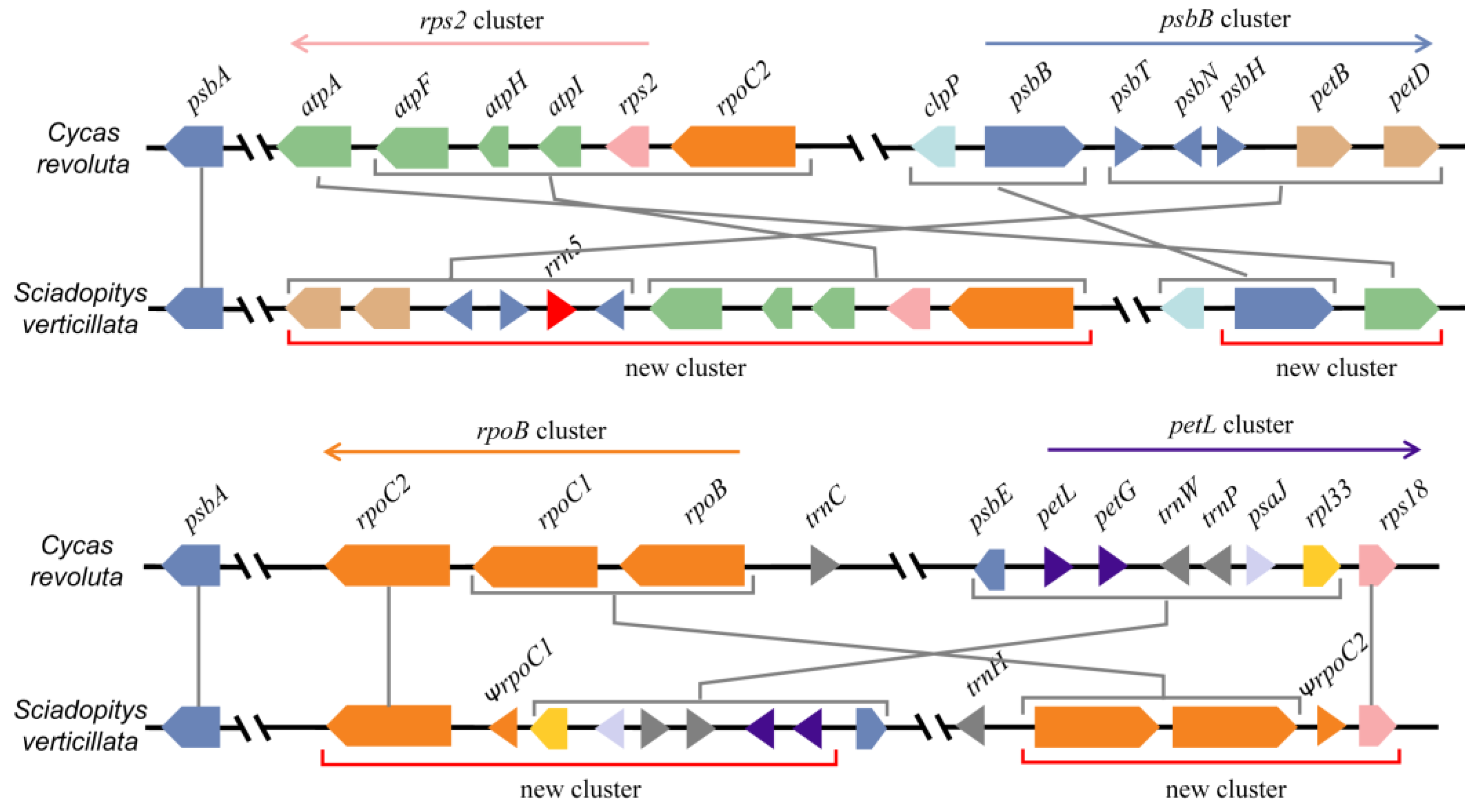
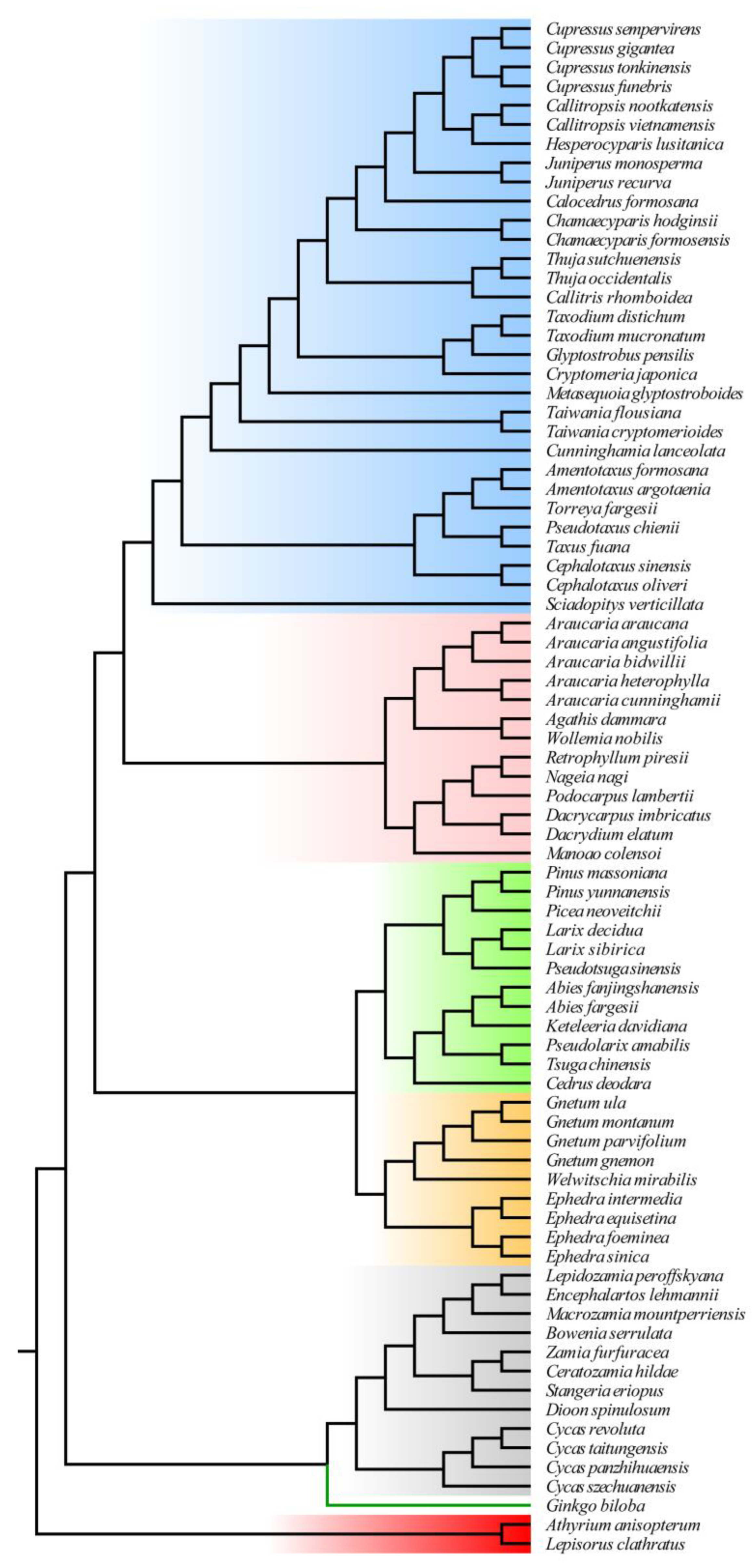

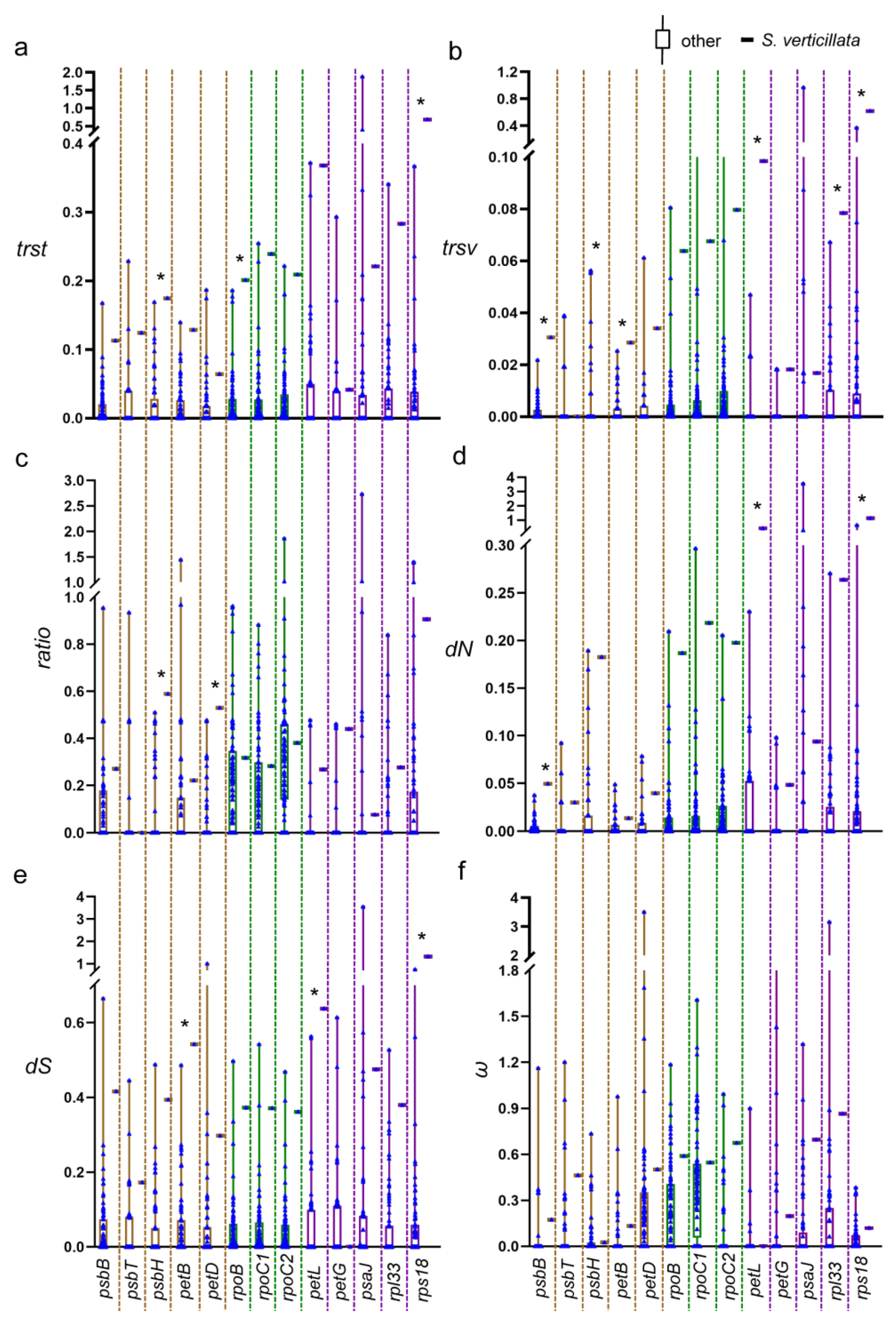
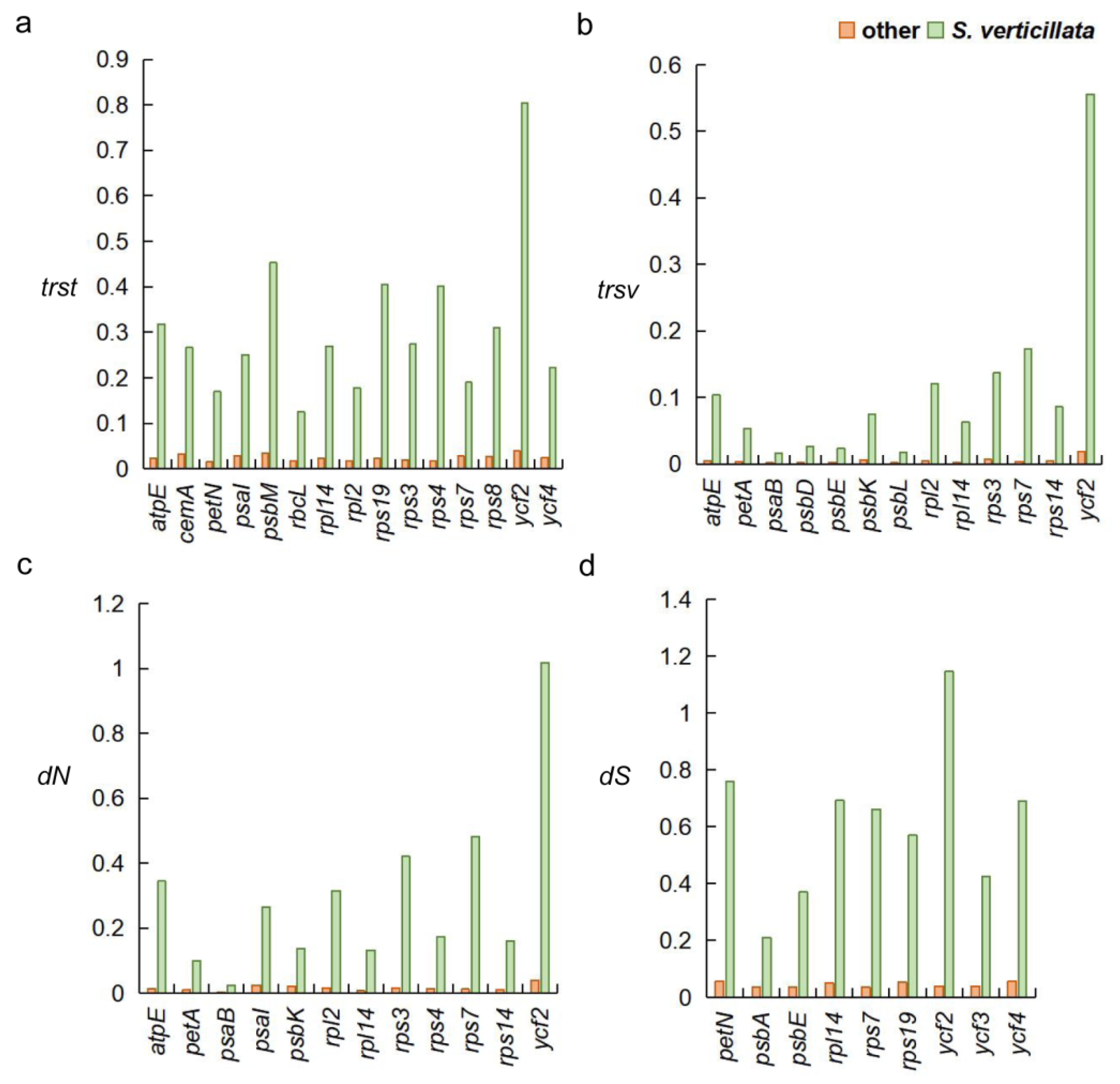
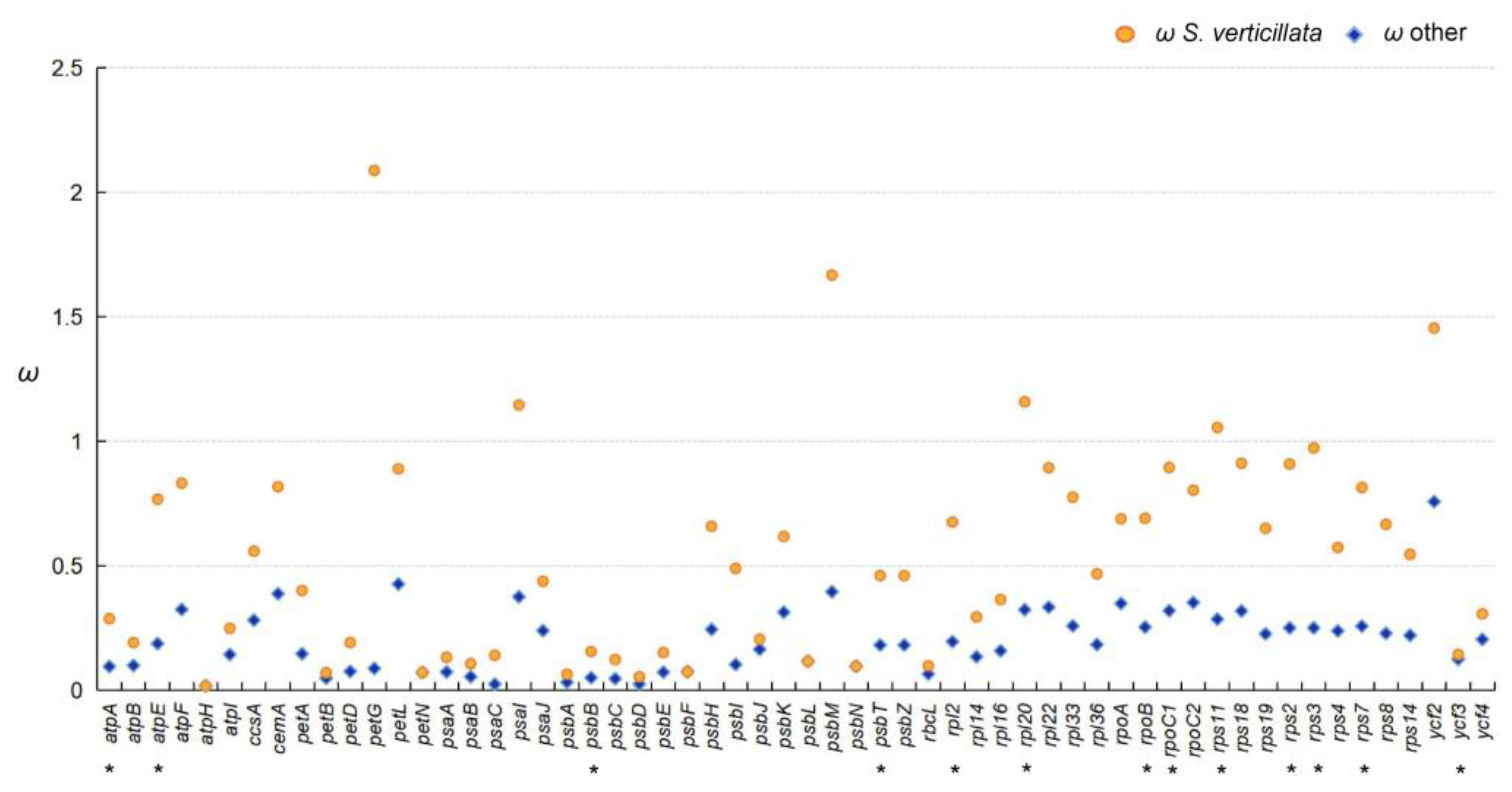
| Faimly Name | Species Name | Genbank Assession No. |
|---|---|---|
| Cycadaceae | Cycas revoluta Thunb. | JN867588 |
| Cycas panzhihuaensis L. Zhou & S. Y. Yang | KX713899 | |
| Cycas szechuanensis W. C. Cheng & L. K. Fu | MH341576 | |
| Cycas taitungensis C. F. Shen, K. D. Hill, C. H. Tsou & C. J. Chen | AP009339 | |
| Zamiaceae | Stangeria eriopus (Kunze) Baill. | JX416858 |
| Ceratozamia hildae G. P. Landry & M. C. Wilson | JX407108 | |
| Dioon spinulosum Dyer ex Eichler | LC049070 | |
| Zamia furfuracea L. f. | JX416857 | |
| Encephalartos lehmannii Lehm. | LC049336 | |
| Lepidozamia peroffskyana Regel | LC049207 | |
| Macrozamia mountperriensis F. M. Bailey | LC049069 | |
| Bowenia serrulata (W. Bull) Chamb. | JX402774 | |
| Ginkgoaceae | Ginkgo biloba L. | NC_016986 |
| Gnetaceae | Gnetum montanum Markgr. | KC427271 |
| Gnetum parvifolium (Warb.) C. Y. Cheng ex Chun | AP009569 | |
| Gnetum ula Brongn. | AP014923 | |
| Gnetum gnemon L. | KP099649 | |
| Ephedraceae | Ephedra equisetina Bunge | AP010819 |
| Ephedra foeminea Forssk. | KT934791 | |
| Ephedra intermedia Schrenk ex C. A. Mey. | MH161421 | |
| Ephedra sinica Stapf | MH161422 | |
| Welwitschiaceae | Welwitschia mirabilis Hook. f. | EU342371 |
| Cupressaceae | Cryptomeria japonica (Thunb. ex L. f.) D. Don | AP009377 |
| Taiwania cryptomerioides Hayata | AP012266 | |
| Taiwania flousiana Gaussen | NC_021441 | |
| Cunninghamia lanceolata (Lamb.) Hook. | KC427270 | |
| Juniperus monosperma (Engelm.) Sarg. | NC_024022 | |
| Juniperus recurva Buch.-Ham. ex D. Don | MK375217 | |
| Taxodium distichum (L.) Rich. | LC177556 | |
| Taxodium mucronatum Ten. | MN535011 | |
| Calocedrus formosana (Florin) Florin | NC_023121 | |
| Cupressus tonkinensis Silba | MH121046 | |
| Cupressus gigantea W. C. Cheng & L. K. Fu | KT315754 | |
| Cupressus sempervirens L. | KP099643 | |
| Callitropsis funebris (Endl.) de Laub. & Husby | MT227813 | |
| Callitropsis nootkatensis (D. Don) Florin | KP099642 | |
| Callitropsis vietnamensis (Farjon & T.H.Nguyen) D.P.Little | KP099645 | |
| Hesperocyparis lusitanica (Mill.) Bartel | MH121051 | |
| Chamaecyparis formosensis Matsum. | LC177668 | |
| Chamaecyparis hodginsii (Dunn) Rushforth | MG269834 | |
| Glyptostrobus pensilis (Staunton ex D.Don) K.Koch | KU302768 | |
| Metasequoia glyptostroboides Hu & W.C.Cheng | NC_027423 | |
| Thuja sutchuenensis Franch. | KY272867 | |
| Thuja occidentalis L. | KY295906 | |
| Callitris rhomboidea R.Br. ex Rich. & A.Rich. | LC177555 | |
| Taxaceae | Cephalotaxus sinensis (Rehder & E. H. Wilson) H. L. Li | MG385662 |
| Cephalotaxus oliveri Mast. | KC136217 | |
| Amentotaxus argotaenia (Hance) Pilg. | KR780582 | |
| Amentotaxus formosana H.L.Li | AP014574 | |
| Taxus fuana Nan Li & R.R.Mill | MF278259 | |
| Pseudotaxus chienii (W.C.Cheng) W.C.Cheng | NC_041503 | |
| Torreya fargesii Franch. | KT027377 | |
| Sciadopityaceae | Sciadopitys verticillata (Thunb.) Siebold & Zucc. | NC_029734 |
| Pinaceae | Cedrus deodara (Roxb. ex D.Don) G.Don | AB480043 |
| Pinus massoniana Lamb. | KC427272 | |
| Pinus yunnanensis Franch. | MK007968 | |
| Pseudolarix amabilis (J. Nelson) Rehder | LC095867 | |
| Pseudotsuga sinensis Dode | MZ779058 | |
| Picea neoveitchii Mast. | MH986606 | |
| Keteleeria davidiana (C. E. Bertrand) Beissn. | AP010820 | |
| Tsuga chinensis (Franch.) E. Pritz. | LC095866 | |
| Larix sibirica Ledeb. | MF795085 | |
| Larix decidua Mill. | AB501189 | |
| Abies fargesii Franch. | MH706716 | |
| Abies fanjingshanensis W. L. Huang, Y. L. Tu & S. Z. Fang | MH706717 | |
| Podocarpaceae | Nageia nagi (Thunb.) Kuntze | NC_023120 |
| Podocarpus lambertii Klotzsch ex Endl. | NC_023805 | |
| Dacrycarpus imbricatus (Blume) de Laub. | NC_034942 | |
| Retrophyllum piresii (Silba) C. N. Page | NC_024827 | |
| Dacrydium elatum (Roxb.) Wall. ex Hook. | NC_045880 | |
| Manoao colensoi (Hook.) Molloy | NC_044893 | |
| Araucariaceae | Agathis dammara (Lamb.) Rich. & A. Rich. | NC_023119 |
| Wollemia nobilis W. G. Jones, K. D. Hill & J. M. Allen | KP259800 | |
| Araucaria cunninghamii Mudie | MT227812 | |
| Araucaria angustifolia (Bertol.) Kuntze | NC_039155 | |
| Araucaria heterophylla (Salisb.) Franco | NC_026450 | |
| Araucaria araucana (Molina) K. Koch | NC_045394 | |
| Araucaria bidwillii Hook. | NC_045395 | |
| Polypodiaceae | Lepisorus clathratus (C. B. Clarke) Ching | NC_035739 |
| Athyriaceae | Athyrium anisopterum Christ | NC_035738 |
| Gene Type | Gene Name | |
|---|---|---|
| Genes for photosynthesis | Photosystem Ⅰ | psaA psaB psaC psaI psaJ |
| Photosystem Ⅱ | psbA psbB psbC psbD psbE psbF psbH psbI | |
| psbJ psbK psbL psbM psbN psbT psbZ | ||
| Cytochrome | petA petB petD petG petL petN | |
| ATP Synthase | atpA atpB atpE atpF atpH atpI | |
| RubiscoCO large subunit | rbcL | |
| Genetic system genes | Ribosomal Proteins (LSU) | rpl2 rpl14 rpl16 rpl20 rpl22 rpl33 rpl36 |
| Ribosomal Proteins (SSU) | rps2 rps3 rps4 rps7 rps8 rps11 rps14 rps18 rps19 | |
| RNA Polymerase | rpoA rpoB rpoC1 rpoC2 | |
| Others genes | Envelop membrane protein | cemA |
| c-type cytochrome synthesis | ccsA | |
| Hypothetical chloroplast reading frames | ycf2 ycf3 ycf4 | |
| Gene Name | M0 | Model2-1 | 2 ΔƖ | p | ||
|---|---|---|---|---|---|---|
| lnL (np = 160) | lnL (np = 161) | ωSciadopitys verticillata + Callitris rhomboidea | ωother | |||
| rps2 | −8508.885 | −8486.906 | 0.917 | 0.233 | 43.959 | 0 |
| atpI | −6561.487 | −6561.473 | 0.150 | 0.143 | 0.028 | 0.867 |
| atpH | −1392.720 | −1391.571 | 0.000 | 0.018 | 2.299 | 0.129 |
| atpF | −6587.056 | −6585.811 | 0.479 | 0.321 | 2.491 | 0.115 |
| atpA | −13257.085 | −13252.557 | 0.160 | 0.095 | 9.055 | 0.003 |
| Gene Name | M0 | Model2-2 | 2 ΔƖ | p | |||
|---|---|---|---|---|---|---|---|
| lnL (np = 160) | lnL (np = 162) | ωother | ωSciadopitys verticillata | ωCallitris rhomboidea | |||
| rps2 | −8508.885 | −8485.576 | 0.234 | 0.663 | 1.352 | 46.618 | 0 |
| atpI | −6561.487 | −6560.851 | 0.143 | 0.105 | 0.195 | 1.273 | 0.529 |
| atpH | −1392.720 | −1391.571 | 0.018 | 0 | 0 | 2.299 | 0.317 |
| atpF | −6587.056 | −6585.777 | 0.321 | 0.507 | 0.446 | 2.558 | 0.278 |
| atpA | −13257.085 | −13251.853 | 0.095 | 0.192 | 0.125 | 10.464 | 0.005 |
Disclaimer/Publisher’s Note: The statements, opinions and data contained in all publications are solely those of the individual author(s) and contributor(s) and not of MDPI and/or the editor(s). MDPI and/or the editor(s) disclaim responsibility for any injury to people or property resulting from any ideas, methods, instructions or products referred to in the content. |
© 2023 by the authors. Licensee MDPI, Basel, Switzerland. This article is an open access article distributed under the terms and conditions of the Creative Commons Attribution (CC BY) license (https://creativecommons.org/licenses/by/4.0/).
Share and Cite
Ping, J.; Zhong, X.; Wang, T.; Su, Y. The Broken Chloroplast Gene Clusters in Gymnosperms Exhibit Elevated Substitution Rates. Forests 2023, 14, 1681. https://doi.org/10.3390/f14081681
Ping J, Zhong X, Wang T, Su Y. The Broken Chloroplast Gene Clusters in Gymnosperms Exhibit Elevated Substitution Rates. Forests. 2023; 14(8):1681. https://doi.org/10.3390/f14081681
Chicago/Turabian StylePing, Jingyao, Xiaona Zhong, Ting Wang, and Yingjuan Su. 2023. "The Broken Chloroplast Gene Clusters in Gymnosperms Exhibit Elevated Substitution Rates" Forests 14, no. 8: 1681. https://doi.org/10.3390/f14081681




